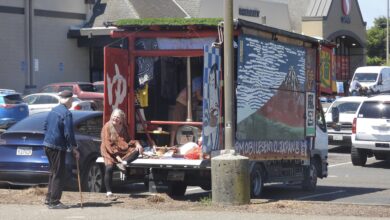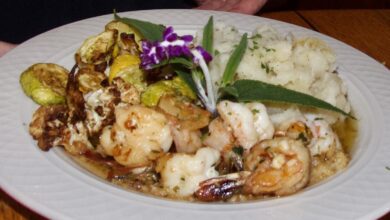Native Americans protest MLPAI
Facebook was key to linking Native Americans who marched through Fort Bragg and took over the Marine Life Protection Act Initiative”s Blue Ribbon Task Force meeting on July 21.
“I don”t have a computer, but I know that a lot of people started talking about it and linking on Facebook and it really took off,” said Melissa Starr-Myers. She lives off the grid along a river near the Humboldt-Del Norte county line and gathers mussels, seaweed and sticks for her baskets.
About 300 Native Americans from all over Northern California, organized by the Coastal Justice Coalition, marched through Fort Bragg last Wednesday, ending up at the MLPAI”s Blue Ribbon Task Force meeting at C.V. Starr Community Center. A cacophony of tribal voices could be heard for about 10 minutes outside the meeting, many chanting phrases like “No Way MLPA,” as the task force”s meeting continued into early afternoon.
Cindy Gustafson, task force chairwoman, greeted the tribes politely as they swarmed in, but held to ground rules, such as boundary line in the room even as tribal members filed in quietly, directed by Frankie Starr-Myers of the Coastal Justice Coalition. She asserted that the task force members are all volunteers who want to listen to the natives but must follow the 1999 Marine Life Protection Act.
Some natives stood passively during the takeover, others held anti-MLPA signs while they gave unscheduled speeches. Fish and Game wardens acting as security officers and city police watched the peaceful, but determined protest.
The Marine Life Protection Act Initiative (MLPAI) is a private organization whose board members are appointed by the state. MLPAI has a legal contract with the State of California to gather public input and prepare preliminary maps of new areas to be closed to fishing. The money comes from the Resources Legacy Foundation Fund (an organization which does not grant interviews) — to implement the Marine Life Protection Act (MLPA), which was signed into law in 1999.
Comments
Ken Wiseman, MLPAI executive director, queried the protesters, “How many people want to speak?”
“We have about 250 people,” Starr-Myers said.
“They all want to speak?” asked Wiseman.
“They all came today to speak,” said Myers, getting support from those around him.
Wiseman said there wasn”t time for that. Gustafson said the agreement was there would be about 30 minutes of public forum and about 10 speeches allowed. The 18 speeches lasted longer than that.
Starr-Myers rebuffed repeated polite and forceful attempts by Gustafson and Wiseman to stop the flow of speakers and show respect to the volunteers.
“I understand what you are saying about respect,” Starr-Myers said. “We are stopping your process you are doing here for one day, you are trying to stop a process that has been going on for thousands of years … We are going to keep talking.”
Gustafson spoke out and said the task force wanted to respond and Starr-Myers agreed they would wrap it up — after a few more speeches.
Thomas O”Rourke, chairman of the Yurok Tribe, said Indians have been told they can”t be granted any rights beyond those of other California citizens.
“I can look back here and see flags that other Californians don”t have … we are more than just citizens of California, we are a nation,” O”Rourke said. “We keep voicing our concerns and you keep failing to hear our voices.”
He said Indians have federal treaty hunting and fishing rights and are not about to enter a negotiating process for “non-negotiable” rights.
“You can keep trying to pull us in and make us negotiate for a little zone here or a little array here, but we will have no part in that,” said O”Rourke. “I believe in management, but we have the ability to manage ourselves.”
Besides, state and federal management of the land and oceans has been a failure, he pointed out.
“I don”t see a history of good management practices, not then, not now. What you are going to do is take everybody from fishing in a vast area and congest them in these smaller, open areas, and pretty soon you are going to have problems in these open areas … You could listen to some masters [of] the people who have taken care of these waters for thousands of years, O”Rourke said.”
Speakers expressed outrage at big corporations harvesting seaweed for cosmetics when the sea holds curative powers and food for many.
“You are saying get out of the way. We are not going to do that anymore,” Air Force veteran Wally Obie told the task force.
“We are tired of that. We have been doing that for 500 years ever since you got here. We should have had better immigration laws,” said Obie.
Bob Juntz, owner of Ocean Fresh in Noyo Harbor, and several Ocean Fresh employees slipped in during the takeover to argue for the jobs that sea urchin harvesting produces.
“There is an ecosystem in Noyo Harbor … a human ecosystem that will be disrupted,” Juntz said.
Gustafson insisted that the private MLPAI was merely enforcing the 1999 law and said the state wouldn”t allow any such protest, but the task force was willing to do so.
That brought a negative response from the Native American group.
Before the protest erupted, the Blue Ribbon Task Force heard that marine ecologist Satie Airame and two of her graduate students have been meeting on behalf of the MLPAI with tribal members and tribal councils and will prepare a report for the regional stakeholders group to be presented next week. Airame said she will summarize the input provided by Native Americans into a single report.
“The input from tribes and tribal communities will be aggregated together to protect confidentiality,” said Airame.
Interviewed outside the room, Starr-Myers said the process and the nature of the funding has made many tribal members suspicious.
“They say they are environmentalists, here to help the fish and the animals. But we look and see organizations like PG&E are involved and the person leading this is a top executive in the oil industry. I didn”t believe that could be possible when somebody first told me that, but it”s true,” Starr-Myers said.
Ironically, the protest hit on the 20th anniversary of one of the biggest protests in Fort Bragg history, as part of “Redwood Summer.” Most people on Wednesday wore matching T-shirts that read “MLPA — taking tribal rights away” and got many honks from locals.
Coalitions
The Coastal Justice Coalition is an offshoot of the Klamath Justice Coalition, which has been boosting activism by Native Americans in recent years. In 2009 the Klamath Justice Coalition organized a similar confrontation with Warren Buffett”s PacifiCorp, demanding the removal of dams on Klamath River owned by the company.
The dams provide irrigation to farmers but have also contributed to the demise of salmon populations that tribal members have harvested for millennia. The action was also good news for commercial fishermen, who have suffered season closures due to the Klamath problems. Dams are now being removed.
The Klamath Justice Coalition has also halted logging in Humboldt County on lands Indians claim as sacred. A current effort is to remove dams from the Eel River, a move that would be a big benefit to salmon but would greatly limit development.
This is the second time the indigenous Californians have “taken over” a Marine Life Protection Act Initiative meeting. On June 29, a smaller group interrupted the MLPAI”s Science Advisory Team meeting in Eureka.
Among those gathered in Fort Bragg were members of the Yurok, Tolowa, Cahto, Pomo, Karuk, Hoopa Valley, Maidu, Hopi, Navajo, and other tribes., a Coastal Justice Coalition release said.
Interviews with the visiting protesters, or listening to their speeches, often meant meeting their ancestors too. Starr-Myers told of her Yurok and Karuk ancestry as well as Irish ones from Tennessee and even a Cherokee from back East.
Later, when public comment resumed about 6 p.m., John W. Corbett, senior attorney for the Yurok Tribe, told the task force that 20 years of ethnic strife could result from an MLPAI actions, with history showing the result will be “some sort of co-management.”
Native speakers all said that Indians would continue their harvesting practices as they had always done, no matter what new rules came out of the MLPAI and no matter if they had to go to jail.
Corbett said the MLPAI could avoid many of the problems if the organization would become more open and transparent. The agenda for the two-day meeting was only sent out this week, a violation of the Bagley-Keene Act”s noticing rules. No printed copies of the agenda were available at the start of the meeting due to printing problems.
Corbett said if the MLPAI could learn to follow the example of city councils, supervisors and other statewide bodies and prepare and send out agendas in a timely (and legal) manner, much of the acrimony could be avoided.
“You get a packet out early, you give everybody seven to 10 days to respond. That would increase the quality of public participation more than anything else,” Corbett said.
He provided handouts to the task force members on standard public meeting protocols.
He said if the tribes knew what was on the agenda ahead of time, they could then compose meaningful scientific, legal and cultural responses. He suggested the task force would like many of the ideas that would come forth if only there was a sensible time frame for the conversation.
With the MLPAI process facing its strongest opposition in Mendocino County of the entire California coast, organizers adapted the task force to include a Native American member, Roberto Cordero, and Humboldt County Supervisor Jimmy Smith, a former commercial fisherman. Previously, it had consisted of harbor developers, an environmental attorney and was led by Catherine Reheis-Boyd, chief lobbyist of the Western States Petroleum Association.
Last Wednesday, Cordero said she was concerned that there were no tribal members on the Science Advisory Team, nor the SAT tribal workgroup and that everything is being determined solely by western science.
Airame said tribal members have been invited to and participated in SAT meetings.
MLPAI Executive Director Ken Wiseman said the Science Advisory Team got only one Native American who he said was a commercial fisherman with a biology degree.
Cordero also encouraged tribal members to explore participating in the process by advocating more marine parks (the least restrictive) and less marine reserves (where all harvesting would stop).
That would likely create conflicts with other users, as it would necessitate larger closed areas.
Later in the 10-hour day for the task force, Priscilla Hunter, representing the Intertribal Sinkyone Wilderness Council, tried to cheer up the grumpy audience with some deadpan humor, stopping to say “that was a joke” twice, her unique style then getting some reluctant laughs.
Hunter explained that the tribe understands the need for environmental preservation and had created a conservation easement on their land which permanently prevents uses such as clear cutting.
“People change, Indians can change too. That”s why we did that.”
Hunter closed by telling the task force that her tribe was featured recently in National Geographic and she had gotten her picture in the magazine.
“And I”m fully clothed in National Geographic,” she said, finally getting a big roar of laughter from the audience.
The protest changed the dynamic in Fort Bragg throughout Wednesday and Thursday. A group of six young Yurok Native American men were carrying homemade signs on Main Street, when they spotted the camera and gave thumbs up and smiles as they backslapped and shoved to get in whatever photo was being taken.
Having ridden hours on busses and in carpools, the Indians were clearly making a day of it. The Farmers Market in Fort Bragg got more customers than ever, reminding some of how Fort Bragg lacks ethnic diversity.
This week”s meeting of the Regional Stakeholders Group will be the last local MLPAI meeting, with two days of meetings at C.V. Starr on July 29-30.
Finding agreement
After early acrimony, Ruby and Sapphire, the two groups split by MLPAI staff have begun to come together recently, task force members heard. Bill Lemos, representative of a national environmental group, said the two sides are now only about 2 percent different, with much more agreement than in the past.
Adam Wagschal, representing the Harbor District in Eureka and a leader of fishing interests, agreed with Lemos that the two groups are closer than ever. There is haggling over the size of reserves at Ten Mile and in Samoa in Humboldt County. Currently, there are no new reserves between Point Arena and Ten Mile.
Maps of the new areas where fishing uses will be prohibited or restricted can be found at www.dfg.ca.gov/mlpa/mpaproposals_nc.asp.
Both Ruby and Sapphire groups have complained about strong-handed facilitators from MLPAI and pleaded for more guidance on the tribal questions. Although the unique way the MLPAI insists on defining and controlling the process continues to cause controversy among many, many have begun to see the light of the ecosystem protection approach being pushed.
Editor”s note: Coverage of the broader MLPA issues from the meeting will continue in next week”s paper.




